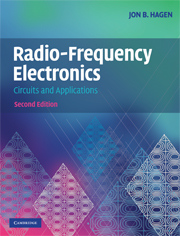Book contents
- Frontmatter
- Contents
- Preface
- 1 Introduction
- 2 Impedance matching
- 3 Linear power amplifiers
- 4 Basic filters
- 5 Frequency converters
- 6 Amplitude and frequency modulation
- 7 Radio receivers
- 8 Suppressed-carrier AM and quadrature AM (QAM)
- 9 Class-C, D, and E Power RF amplifiers
- 10 Transmission lines
- 11 Oscillators
- 12 Phase lock loops and synthesizers
- 13 Coupled-resonator bandpass filters
- 14 Transformers and baluns
- 15 Hybrid couplers
- 16 Waveguide circuits
- 17 Small-signal RF amplifiers
- 18 Demodulators and detectors
- 19 Television systems
- 20 Antennas and radio wave propagation
- 21 Radar
- 22 Digital modulation techniques
- 23 Modulation, noise, and information
- 24 Amplifier and oscillator noise analysis
- 25 The GPS Navigation system
- 26 Radio and radar astronomy
- 27 Radio spectrometry
- 28 S-parameter circuit analysis
- 29 Power supplies
- 30 RF test equipment
- Index
- References
23 - Modulation, noise, and information
Published online by Cambridge University Press: 05 June 2012
- Frontmatter
- Contents
- Preface
- 1 Introduction
- 2 Impedance matching
- 3 Linear power amplifiers
- 4 Basic filters
- 5 Frequency converters
- 6 Amplitude and frequency modulation
- 7 Radio receivers
- 8 Suppressed-carrier AM and quadrature AM (QAM)
- 9 Class-C, D, and E Power RF amplifiers
- 10 Transmission lines
- 11 Oscillators
- 12 Phase lock loops and synthesizers
- 13 Coupled-resonator bandpass filters
- 14 Transformers and baluns
- 15 Hybrid couplers
- 16 Waveguide circuits
- 17 Small-signal RF amplifiers
- 18 Demodulators and detectors
- 19 Television systems
- 20 Antennas and radio wave propagation
- 21 Radar
- 22 Digital modulation techniques
- 23 Modulation, noise, and information
- 24 Amplifier and oscillator noise analysis
- 25 The GPS Navigation system
- 26 Radio and radar astronomy
- 27 Radio spectrometry
- 28 S-parameter circuit analysis
- 29 Power supplies
- 30 RF test equipment
- Index
- References
Summary
In this chapter we examine how noise degrades the accuracy of digital data transmission and the fidelity of analog transmission. We begin with an explanation of matched filtering, a subject which came up in Chapter 22. We show that, for binary data links using matched filtering and coherent detection, the probability of error depends only on the noise level at the input of the receiver and on the energy, but not the shape, of the transmitted pulses. We look at two example systems: BPSK (binary phase-shift keying) with coherent detection and OOK (on–off keying) with envelope detection. The error rates and channel capacities (maximum error-free data rates when using forward error correction coding) are calculated and compared with Shannon's expression for the capacity of a band-limited channel. Finally, traditional AM and FM are examined with respect to their noise characteristics.
Matched filtering
We stated in Chapter 22 that, in the presence of noise, the post-detection signal-to-noise ratio is maximized when the predetection bandpass shape of the receiver is that of a matched filter.
A matched filter is one whose impulse response is proportional to the time-reversed waveform of the incoming signal pulse, as will be shown below. For example, if the input signal is a pulse whose shape is the same as the symmetric impulse response of a root raised-cosine filter, then the receiver should use a root raised-cosine filter or an equivalent cascade of filters.
- Type
- Chapter
- Information
- Radio-Frequency ElectronicsCircuits and Applications, pp. 321 - 335Publisher: Cambridge University PressPrint publication year: 2009



